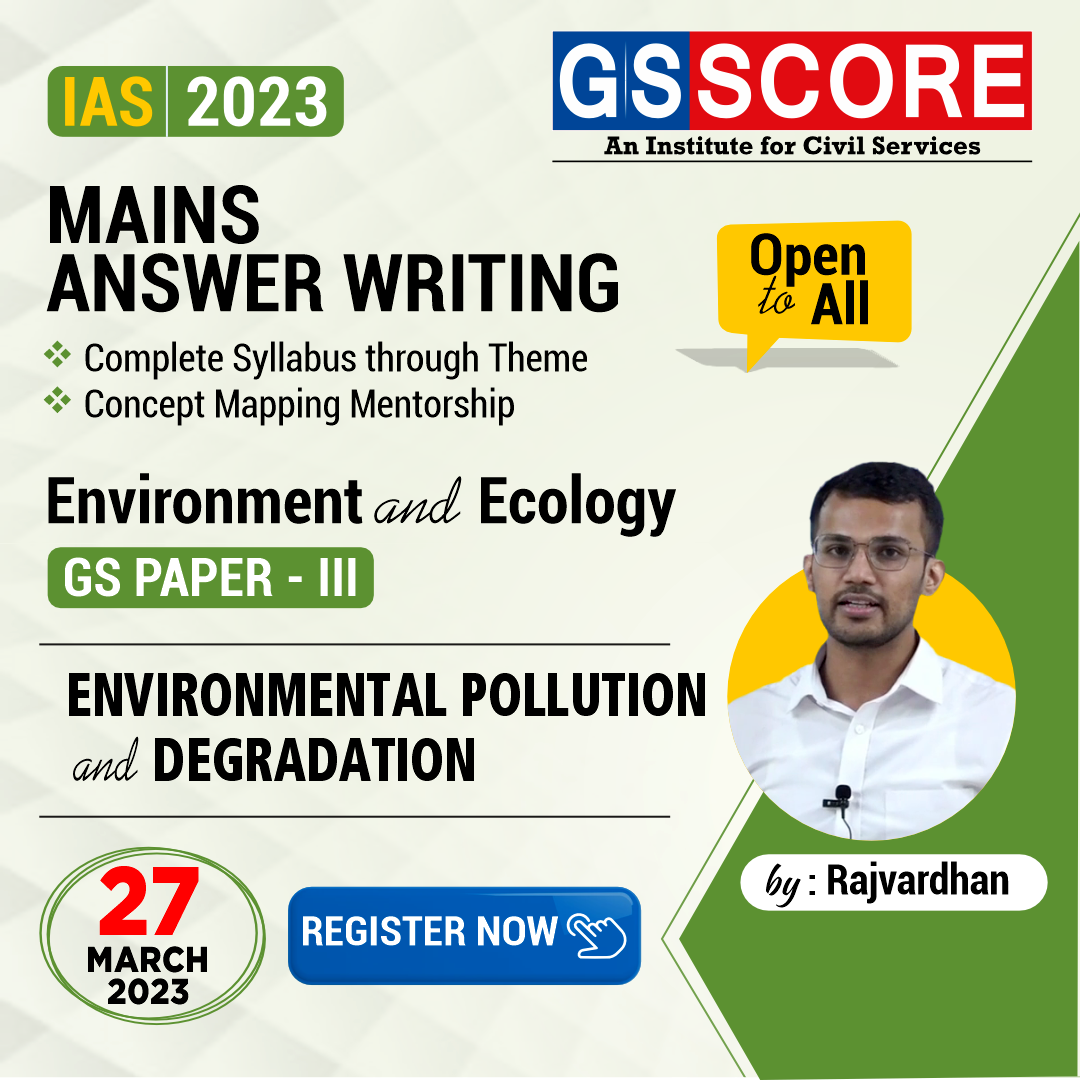


Instruction:
- There will be 2 questions carrying 10 marks each. Write your answers in 150 words
- Any page left blank in the answer-book must be crossed out clearly.
- Evaluated Copy will be re-uploaded on the same thread after 2 days of uploading the copy.
- Discussion of the question and one to one answer improvement session of evaluated copies will be conducted through Google Meet with concerned faculty. You will be informed via mail or SMS for the discussion.
Question #1. Describe the benefit of Deriving Electric Energy Form sunlight in Contrast to the Conventional Energy generation. What are the initiative offered by our government for this purpose ?
Question #2. Discuss in detail the photochemical smog emphasizing its, Formation effects and mitigation Explain the 1999 Gothenburg protocol.
(Examiner will pay special attention to the candidate's grasp of his/her material, its relevance to the subject chosen, and to his/ her ability to think constructively and to present his/her ideas concisely, logically and effectively).
STEPS & INSTRUCTIONS for uploading the answers
Step 1 - The Question for the day is provided below these instructions. It will be available at 7:00 AM.
Step 2 - Uploading of Answers : Write the answer in A4 Sheet leaving proper margins for comments and feedback and upload the PDF in MY ACCOUNT section. Click on the option of SUBMIT COPY to upload the PDF.
Step 3 - Deadline for Uploading Answers: The students shall upload their answers by 7:00 PM in the evening same day. The first 50 copies will be evaluated.
Step 4 - Feedback : Mentors will give their feedback for the answers uploaded. For more personalised feedback, join our telegram channel by clicking on the link https://t.me/mains_answer_writing_cse . A one-to-one session will be conducted with the faculty after copy evaluation in 72 Hrs.
Model Answer
Question #1. Describe the benefit of Deriving Electric Energy Form sunlight in Contrast to the Conventional Energy generation. What are the initiative offered by our government for this purpose ?
Hints:
- As a part of lunate action, electric energy derived from sunlight which is a part green energy is being promoted.
Benefits
- Accessible to all almost throughout the year, as India is a tropical country
- Availability is 24 × 7 even during natural calamities during which transaction wires collapse.
- Affordable – a per unit cost is less than Rs. 3
- Dependency on fossil fuels will – improvement w.r.t. cc.
- Less initial cost compared to other RE resources.
- Not harmful impact on environment.
- Energy for all – can be setup in remote & inaccessible areas.
- Inexhaustible source of energy.
Initiatives
- National Solar Mission
- International Solar Alliance
- PM KVSUM Yojana – Annadata to Urjadata
- 100% FDI in solar projects under antomatic route
- Solar Park Scheme – to setup solar parts with nearly 500 new capacity.
Conclusion
- In the contest of increasing climate change induced disasters, it is important to increase case of solar energy as well as other forms renewable energy. For this cooperation of context and States is important. Also private sector should be encouraged to play its role in harvesting renewable energy.
Question #2. Discuss in detail the photochemical smog emphasizing its, Formation effects and mitigation Explain the 1999 Gothenburg protocol.
Hints:
- Photochemical smog is a brown, hazy mixture of pollutants, especially Ozone and Peroxyacetyl Nitrate, formed when sunlight reacts with oxides of nitrogen and Volatile Organic Compounds. Photochemical smog is also known as "Summer Smog" as it occurs more in summers due to abundance of sunlight.
Formation of Photochemical Smog:
- Nitrogen oxides (NOx) and Volatile Organic Compounds (VOCs) react in the presence of Ultraviolet light in the sunlight
- The complex reaction results in the creation of Ozone (03) and Peroxyacetyl Nitrate (PAN) which is Photochemical smog
- Formation Equation:
- NO + VOC—* NO,
- NO,+ UV— NO + 0 (atomic oxygen)
- 0 + O,— 0, (tropospheric Ozone)
- NO, + VOC— PAN (peroxyacetyl Nitrate)
Effects of Photochemical Smog:
Health Effects:
- Serious irreversible damage to lungs and heart due to lung inflammation which releases interleukin-6 which causes blood clots leading to heart attacks or strokes
- Painful irritation in the respiratory tracts and difficulty breathing
- Reduced lung function
- Triggers asthma due to sensitivity to allergens
- Protective mucous of the nose and throat dry out
- Reduces the body's ability to resist infection
Environmental Effects:
- Affects respiratory health of animals
- Causes necrosis or tissue death in plants and trees, further affecting green cover
- Ground level ozone also affects productivity of trees
- Crops like tomato, spinach are highly sensitive to smog and get decimated
Other effects include Corrosion of metal, stone, rubber and other painted surfaces
Mitigation of Photochemical smog
- Primary pollutants such as Nitrogen oxides and Volatile Organic Compounds (VOCs) as well as secondary pollutants like Tropospheric Ozone and Peroxyacetyl Nitrates need to be controlled
- Catalytic converters prevent the release of NOx and VOCs
- Fossil Fuels must be phased out to reduce the emission of NOx and VOCs
- Adoption of clean, renewable energy
- Increasing energy efficiency to reduce emissions
- Using Smoke Towers that filter out pollutants from the air. Example: 2 smog towers installed in Delhi and also seen in China
Gothenburg protocol
- Known as the 1999 Gothenburg protocol to abate Acidification, Eutrophication and Ground Level Ozone or also "Multi Effect protocol"
- Launched by United nations Economic Commission for Europe (UNECE)
- The protocol sets emissions ceilings for NOx, Sulphur, VOCs, and Ammonia
- Implementation was expected to reduce sulphur emissions there by at least 63%, NOx emissions by 41%, VOC emissions by 40% and ammonia emissions by 17% compared to levels in 1990
- Gothenburg protocol is part of the Convention on Long Range Transboundary Pollution Pollution.
Conclusion
- India's measures like target of 500 GW of Renewable energy by 2030, promotion of electronic vehicles (FAME Scheme), Green India Mission, National Green Hydrogen/ Green Ammonia are some of the initiatives that will go a long way in reducing Photochemical Smog.

